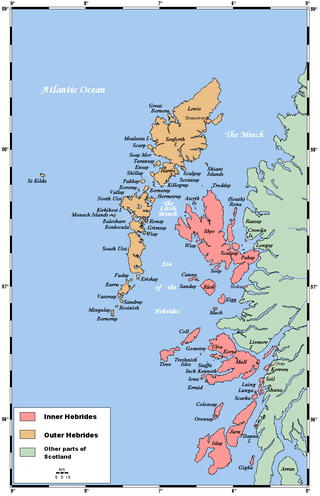
The Hebrides are an archipelago off the west coast of the Scottish mainland. The islands fall into two main groups, based on their proximity to the mainland: the Inner and Outer Hebrides.

The Highlands is a historical region of Scotland. Culturally, the Highlands and the Lowlands diverged from the Late Middle Ages into the modern period, when Lowland Scots replaced Scottish Gaelic throughout most of the Lowlands. The term is also used for the area north and west of the Highland Boundary Fault, although the exact boundaries are not clearly defined, particularly to the east. The Great Glen divides the Grampian Mountains to the southeast from the Northwest Highlands. The Scottish Gaelic name of A' Ghàidhealtachd literally means "the place of the Gaels" and traditionally, from a Gaelic-speaking point of view, includes both the Western Isles and the Highlands.

The Inner Hebrides is an archipelago off the west coast of mainland Scotland, to the south east of the Outer Hebrides. Together these two island chains form the Hebrides, which experience a mild oceanic climate. The Inner Hebrides comprise 35 inhabited islands as well as 44 uninhabited islands with an area greater than 30 hectares. Skye, Mull, and Islay are the three largest, and also have the highest populations. The main commercial activities are tourism, crofting, fishing and whisky distilling. In modern times the Inner Hebrides have formed part of two separate local government jurisdictions, one to the north and the other to the south. Together, the islands have an area of about 4,130 km2 (1,594 sq mi), and had a population of 18,948 in 2011. The population density is therefore about 4.6 inhabitants per square kilometre.
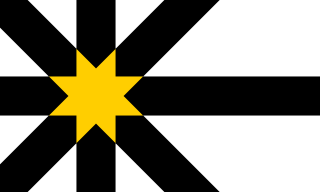
Sutherland is a historic county, registration county and lieutenancy area in the Highlands of Scotland. Its county town is Dornoch. Sutherland borders Caithness and Moray Firth to the east, Ross-shire and Cromartyshire to the south and the Atlantic to the north and west. Like its southern neighbour Ross-shire, Sutherland has some of the most dramatic scenery in Europe, especially on its western fringe where the mountains meet the sea. These include high sea cliffs, and very old mountains composed of Precambrian and Cambrian rocks.

The Slate Islands are an island group in the Inner Hebrides, lying immediately off the west coast of Scotland, north of Jura and southwest of Oban. The main islands are Seil, Easdale, Luing, Shuna, Torsa and Belnahua. Scarba and Kerrera, which lie nearby are not usually included.
Torsa is one of the Slate Islands in Argyll and Bute, Scotland. Lying east of Luing and south of Seil, this tidal island was inhabited until the 1960s. There is now only one house there, which is used for holiday lets. The underlying bedrock is slate but unlike Torsa's immediate island neighbours this has never been worked commercially. The island's name is of Norse origin but the most prominent historical structure on the island is the ruined Caisteal nan Con on the northeast shore, once held by Clan Campbell. The abundant sea life in the waters surrounding the island are protected by the Loch Sunart to the Sound of Jura Marine Protected Area.

The University of the Highlands and Islands (UHI) is an integrated, tertiary institution encompassing both further and higher education. It is composed of 12 colleges and research institutions spread around the Highlands and Islands, Moray and Perthshire regions of Scotland. UHI offers further education, undergraduate, postgraduate and research programmes which can be studied at a range of locations across the area and online. It has 31,000 students, including 19,779 further education students and 11,210 higher education students.

Strathnaver or Strath Naver is the fertile strath of the River Naver, a famous salmon river that flows from Loch Naver to the north coast of Scotland. The term has a broader use as the name of an ancient province also known as the Mackay Country, once controlled by the Clan Mackay and extending over most of northwest Sutherland.
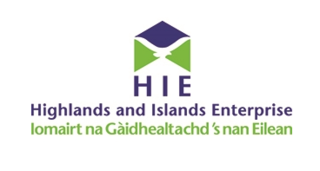
Highlands and Islands Enterprise is the development agency for the Highlands and Islands of Scotland. It is an executive non-departmental public body of the Scottish Government. Its role is to "help build a prosperous, sustainable and inclusive economy across the Highlands and Islands, attracting more people to live, work, study, invest and visit."
Hamish Brown M.B.E. FRSGS is a professional writer, lecturer and photographer specialising in mountain and outdoor topics. He is best known for his walking exploits in the Scottish Highlands, having completed multiple rounds of the Munros and being the first person to walk all the Munros in a single trip with only ferries and a bicycle as means of transport.
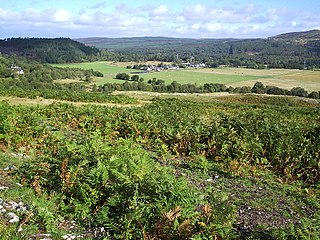
Culrain (Cul Raoin) is a small village in Sutherland, Highland, Scotland.
Garmoran is an area of western Scotland. It lies at the south-western edge of the present Highland Region. It includes Knoydart, Morar, Moidart, Ardnamurchan, and the Small Isles.

The Isle of Skye, or simply Skye, is the largest and northernmost of the major islands in the Inner Hebrides of Scotland. The island's peninsulas radiate from a mountainous hub dominated by the Cuillin, the rocky slopes of which provide some of the most dramatic mountain scenery in the country. Although Sgitheanach has been suggested to describe a winged shape, no definitive agreement exists as to the name's origins.

The Highland Clearances were the forced evictions of a significant number of tenants in the Scottish Highlands and Islands, mostly in two phases from 1750 to 1860.

Ben Bhraggie is a hill in Scotland which rises to an elevation of 397 metres (1,302 ft) above sea level. The hill dominates the skyline above the village of Golspie and is visible from many parts of east Sutherland. The 100-foot-tall (30-metre) statue which is perched on top is that of George Leveson-Gower, Marquess of Stafford and first Duke of Sutherland who became notorious through the part he played in the Highland clearances.

Strath of Kildonan, also known as Strath Ullie,, is a strath in Sutherland, in the north of Scotland. It extends in a north-westerly direction from Helmsdale towards Kinbrace.
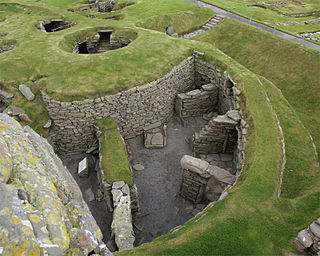
Prehistoric Shetland refers to the prehistoric period of the Shetland archipelago of Scotland, when it was first occupied by humans. The period prior to human settlement in Shetland is known as the geology of Scotland. Prehistory in Shetland does not end until the beginning of the Early Medieval Period in Scotland, around AD 600. More than 5,000 archaeological sites have been recorded in the Shetland Islands.

Lochalsh is a district of mainland Scotland that is currently part of the Highland council area. The Lochalsh district covers all of the mainland either side of Loch Alsh - and of Loch Duich - between Loch Carron and Loch Hourn, ie. from Stromeferry in the north on Loch Carron down to Corran on Loch Hourn and as (south-)west as Kintail. It was sometimes more narrowly defined as just being the hilly peninsula that lies between Loch Carron and Loch Alsh. The main settlement is Kyle of Lochalsh, located at the entrance to Loch Alsh, opposite the village of Kyleakin on the adjacent island of Skye. A ferry used to connect the two settlements but was replaced by the Skye Bridge in 1995.
Barbara Elizabeth Crawford OBE FRSE FSA FSA(Scot) is a British historian. She is a leading authority on the mediaeval history of the Northern Isles of Scotland and Norwegian-Scottish 'frontier' and relations across the North Sea. She is Honorary Reader in Mediaeval History at the University of St Andrews, and Honorary Professor at the University of the Highlands and Islands. She was awarded an OBE for services to History and Archaeology in 2011. She became a Member of the Norwegian Academy in 1997 and was elected a Fellow of the Royal Society of Edinburgh in 2001.














